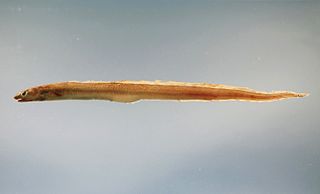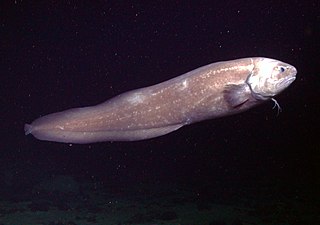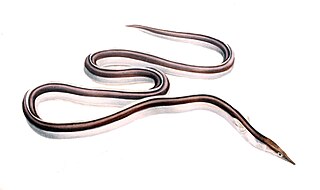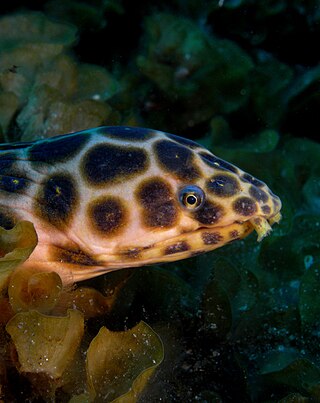
Conger is a genus of marine congrid eels. It includes some of the largest types of eels, ranging up to 2 m (6 ft) or more in length, in the case of the European conger. Large congers have often been observed by divers during the day in parts of the Mediterranean Sea, and both European and American congers are sometimes caught by fishermen along the European and North American Atlantic coasts.

Ophichthidae is a family of fish in the order Anguilliformes, commonly known as the snake eels. The term "Ophichthidae" comes from Greek ophis ("serpent") and ichthys ("fish"). Snake eels are also burrowing eels. They are named for their physical appearance, as they have long, cylindrical, snake-like bodies. This family is found worldwide in tropical to warm temperate waters. They inhabit a wide range of habitats, from coastal shallows and even rivers, to depths below 800 m (2,600 ft). Most species are bottom dwellers, hiding in mud or sand to capture their prey of crustaceans and small fish, but some are pelagic.

The cusk-eel family, Ophidiidae, is a group of marine bony fishes in the Ophidiiformes order. The scientific name is from the Greek ophis meaning "snake", and refers to their eel-like appearance. True eels diverged from other ray-finned fish during the Jurassic, while cusk-eels are part of the Percomorpha clade, along with tuna, perch, seahorses and others.

The serpent eel or sand snake-eel is an eel found in the eastern Atlantic Ocean, western Mediterranean Sea, western Indian Ocean, western Pacific Ocean and the north-east and west coast of North Island in New Zealand. It is an elongated, slender fish with a length of up to 250 centimetres. It spends the day with its body immersed in the sediment, emerging into the open water at night.

Eels are ray-finned fish belonging to the order Anguilliformes, which consists of eight suborders, 20 families, 164 genera, and about 1000 species. Eels undergo considerable development from the early larval stage to the eventual adult stage and are usually predators.
Brachysomophis atlanticus is an eel in the family Ophichthidae. It was described by Jacques Blache and Luiz Vieria Caldas Saldanha in 1972. It is a tropical, marine eel which is known from the eastern Atlantic Ocean, including Senegal and the Gulf of Guinea. It inhabits the continental shelf, and makes burrows in sand and mud. Males can reach a maximum total length of 27.3 centimetres.

The saddled snake-eel, also known commonly as the halfbanded snake-eel, the banded snake eel, or the culverin, is an eel in the family Ophichthidae. It was described by George Tradescant Lay and Edward Turner Bennett in 1839, originally under the genus Ophisurus. It is a marine, tropical eel which is known from the Indo-Pacific and southeastern Atlantic Ocean, including East and South Africa, the Hawaiian Islands, the Marquesan Islands, the Mangaréva islands, Japan, and Australia. It dwells at a depth range of 0 to 70 metres, most often around 0 to 10 metres, and inhabits lagoons and reefs, in which it forms burrows in beds of seagrass and sandy areas. Males can reach a maximum total length of 66 centimetres (2.17 ft).

The leopard eel is an eel in the worm or snake eels family, Ophichthidae. It was described by Achille Valenciennes in 1839, originally under the genus Ophisurus.
Ophichthus celebicus is an eel in the family Ophichthidae. It was described by Pieter Bleeker in 1856, originally under the genus Ophisurus. It is a marine, tropical eel which is known from the western Pacific Ocean, including India and Hong Kong.
Ophichthus grandoculis, known commonly as the snake-eel in Malaysia, is an eel in the family Ophichthidae. It was described by Theodore Edward Cantor in 1849, originally under the genus Ophisurus. It is a marine, tropical eel which is known from Malaysia, in the eastern Indian Ocean.
The ornate snake eel, also known as the sea snake in St. Helena is an eel in the family Ophichthidae. It was described by John Richardson in 1848, originally under the genus Ophisurus. It is a marine, tropical eel which is known from the eastern Atlantic Ocean, including Mauritania, St. Helena, and Ascension Island. It inhabits the continental shelf, where it forms burrows in sand sediments. Males can reach a maximum total length of 90 centimetres (35 in).

The punctuated snake eel is an eel in the family Ophichthidae. It was described by Achille Valenciennes in 1837, originally under the genus Ophisurus. It is a marine, subtropical eel which is known from the eastern central and southeastern Pacific Ocean, including Nicaragua, Chile, Colombia, Costa Rica, Ecuador, Peru, and Panama. It dwells at a depth range of 15 to 277 metres, and inhabits sand and mud sediments. Males can reach a maximum total length of 85 centimetres (33 in), but more commonly reach a TL of 60 centimetres (24 in).

The olive snake eel is an eel in the family Ophichthidae. It was described by Pieter Bleeker in 1853, originally under the genus Ophisurus. It is a marine, tropical eel which is known from the Indo-Pacific. It forms burrows in soft sediments in shallow waters, and leads a nocturnal lifestyle. Males can reach a maximum total length of 95 centimetres (37 in).

Ophisurus macrorhynchos is an eel in the family Ophichthidae. It was described by Pieter Bleeker in 1853. It is a marine, temperate water-dwelling eel which is known from the Indo-Western Pacific and Atlantic Ocean. Males can reach a maximum total length of 140 centimetres (55 in), but more commonly reach a TL of 60 centimetres (24 in).

The rice-paddy eel is an eel in the family Ophichthidae. It was described by Francis Buchanan-Hamilton in 1822, originally in the genus Ophisurus. It is a tropical, marine eel which is known from the Indo-West Pacific, including Somalia, Tanzania, South Africa, India, Pakistan, Sri Lanka, Indonesia, Polynesia, Australia, Bangladesh, Cambodia, Kenya, Madagascar, the Philippines, Malaysia, Mozambique, Seychelles, Saudi Arabia, Taiwan, China, Thailand, Vietnam, and southern Yemen. It is an anadromous species and spawns in freshwater, often in rice paddies during the rainy season, earning it its common name. It also spends time in lagoons, estuaries and coastal rivers, in which it lives in burrows in the river bottom and bank. Males can reach a maximum total length (TL) of 100 centimetres, but more commonly reach a TL of 70 cm.
Pisodonophis hijala is an eel in the family Ophichthidae. It was described by Francis Buchanan-Hamilton in 1822, originally under the genus Ophisurus. It is a marine, tropical eel which is known from the Indo-Pacific.
Hoeven's snake eel is an eel in the family Ophichthidae. It was described by Pieter Bleeker in 1853, originally under the genus Ophisurus. It is a marine, tropical eel which is known from three specimens found in the Indo-Western Pacific, including Sulawesi, Indonesia, the Persian Gulf and the Gulf of Oman. It is known to inhabit shallow water and lagoons. Males are known to reach a total length of 22 centimetres (8.7 in).
Pisodonophis hypselopterus is an eel in the family Ophichthidae. It was described by Pieter Bleeker in 1851, originally under the genus Ophisurus. It is a tropical, freshwater and brackish water-dwelling eel which is known from Borneo, Indonesia, and Pohnpei in Asia. Males can reach a maximum total length of 75 centimetres (30 in).
Xyrias guineensis is an eel in the family Ophichthidae. It was described by Jacques Blache in 1975, originally under the genus Ophisurus. It is a marine, deep water-dwelling eel which is known from Pointe Noire, Congo, in the eastern Atlantic Ocean. It is known to dwell at a depth of 300 metres (980 ft), and inhabits burrows formed in sand and mud sediments on the continental shelf. Males can reach a maximum total length of 63.6 centimetres (25.0 in).










